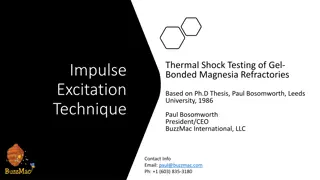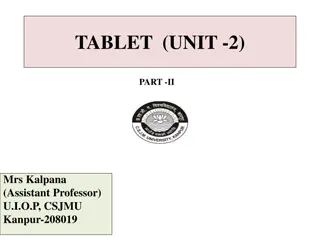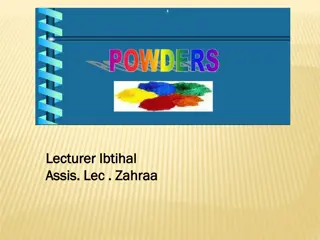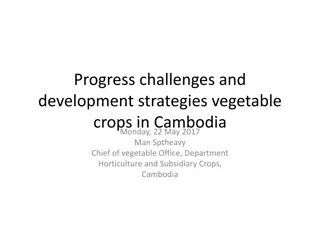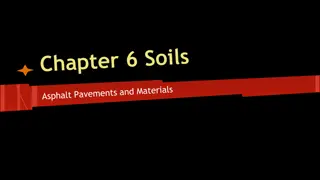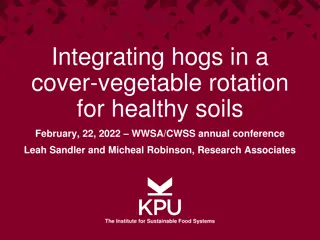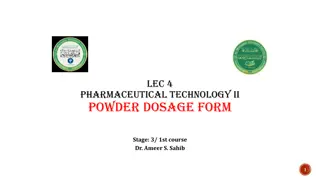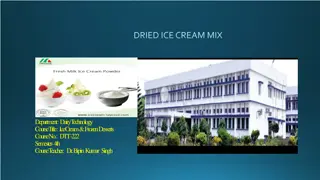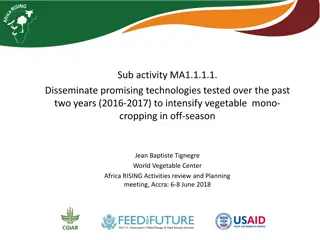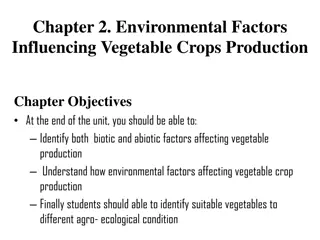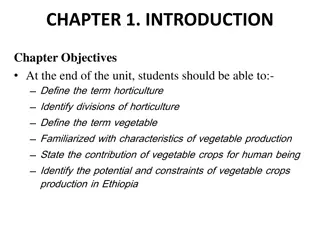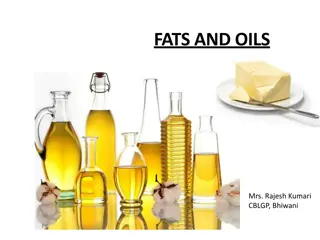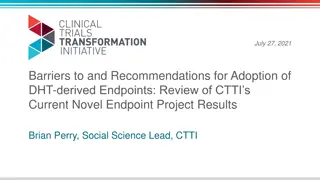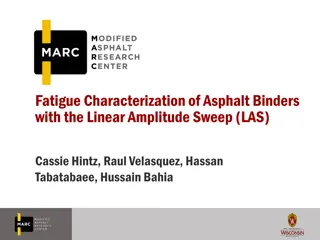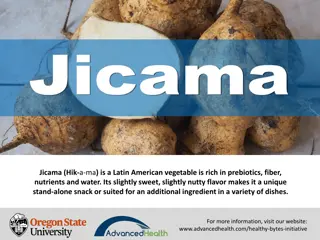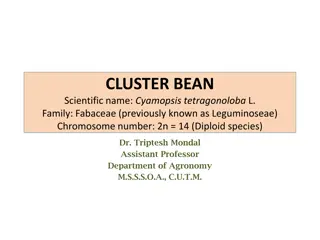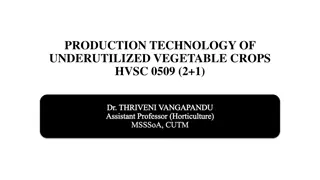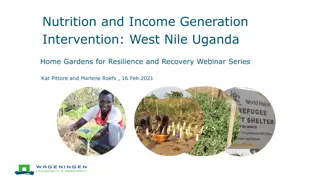Evaluation of Sustainable Vegetable-derived Binders in Pressed Powders
This study by Diogo Baltazar, Elise Velkeneers, and Slobodanka Tamburic from London College of Fashion examines the use of sustainable, vegetable-based binders as alternatives to Dimethicone in pressed powders. The aim is to address consumer demand for silicone-free products by exploring materials from natural and sustainable sources. Comparative data is lacking, prompting an inter- and intra-formulary study to evaluate different binders and press strengths. The research includes formulation, testing of bulk powder characteristics, stability assessment, and performance evaluations using various protocols such as drop testing, hardness measurement, and eyeshadow and lipstick payoff assessments.
Download Presentation

Please find below an Image/Link to download the presentation.
The content on the website is provided AS IS for your information and personal use only. It may not be sold, licensed, or shared on other websites without obtaining consent from the author. Download presentation by click this link. If you encounter any issues during the download, it is possible that the publisher has removed the file from their server.
E N D
Presentation Transcript
Replacing Dimethicone as a binder in pressed powders with vegetable-derived alternatives Diogo Baltazar, Elise Velkeneers and Slobodanka Tamburic Cosmetic Science Research Group, London College of Fashion, London, UK
Introduction and Aim Growing consumer scepticism regarding silicones has prompted the of demand silicone-free products formulated with materials from natural and sustainable sources; The industry has extracted and refined natural vegetable- based emollients as alternatives, but there is a lack of comparative data in the literature. Aim of this project: To evaluate the use of sustainable, vegetable-derived binders in pressed powders against a silicone standard, via an inter- and intra-formulary study using different binders and press strengths.
Materials Base formulation ingredients: Talc, Methylparaben, Propylparaben Pigment: CI 77510 (Ferric Ferrocyanide; Prussian Blue; Iron Blue) Binders DOS Dimethicone (DM) Vegetable-based binders: Diisooctyl Succinate (DOS) TH Triheptanoin (TH) Heptyl Undecylenate (HU) HU Fig. 1 Molecular structure of vegetable-based binders
Methods: formulation 1. Phase A milling; 2. Phase B add to Phase A + milling; 3. Bulk powder left to stand for 24 h; 4. Pressing @ 1000 or 2000 psi Table 1. Pressed powder formulations Phase INCI % (w/w) Talc Ad 100% CI 77510 10.00 A Methylparaben 0.20 Propylparaben 0.10 Binder variables: Dimethicone 3.0 - 6.0 - 9.0 Diisooctyl Succinate 3.0 - 6.0 - 9.0 B Triheptanoin 3.0 - 6.0 - 9.0 Heptyl Undecylenate 3.0 - 6.0 - 9.0
Methods: testing bulk powder and colour Bulk powder testing to characterise powder flow and compressibility, according to the British Pharmacopoeia: Aerated and tapped bulk densities (to obtain Hausner ratio and Carr index); Angle of repose. Colour (L* a* b*), spectrophotometer, Konica Minolta; Variation: E = (?1 ?2)2+(?1 ?2)2+ (?1 ?2)2 Stability testing: Accelerated: 40 C, 10 weeks; followed by E Indirect sunlight: RT, 10 weeks; followed by E Xenon weathering: 765 W/m2, 24 h; followed by E, adapted from L Or al s QAC-MC-151 standard.
Methods: testing compact powder Drop test: 30 cm drop onto a flat surface, 3 times; adapted from ASTM D5276; Hardness: 2 mm probe with a TA.XTplus Texture Analyser (Stable Micro Systems, UK); Eyeshadow Test Protocol and using the Exponent software. Payoff new method: Weighing, followed by testing: TA.XTplus Texture Analyser; Lipstick cantilever rig; Makeup brush; 10 passes, followed by weighing. Fig. 2 Payoff method with a cantilever rig on the TA.XTplus
Results E vs formulation variables DOS, TH and HU increased Hausner ratio/Carr s index and powder flow properties, thus performing better than DM. E over 2.5 is considered a visible difference to the human eye; E was high between samples with DM and those with vegetable- based binders the latter gave higher colour intensity. Table 2. E between press strengths 18 Pressed Powder Benchmark DOS 3% DOS 6% DOS 9% DM 3% DM 6% DM 9% HU 3% HU 6% HU 9% TH 3% TH 6% TH 9% E 1000 vs 2000 psi 0.25 2.86 2.00 2.35 0.50 0.35 2.19 1.98 2.00 4.21 0.67 0.69 1.99 16 14 12 10 E 8 6 4 2 0 DOS @ 1000 psi DOS @ 2000 psi DM @ 1000 psi DM @ 2000 psi HU @ 1000 psi HU @ 2000 psi TH @ 1000 psi TH @ 2000 psi 3% vs. 6% 6% vs. 9% 3% vs. 9% Fig. 3 E between powders with same binder at different concentrations
Results E vs stability testing Samples with DM consistently showed a high E when compared to samples with vegetable-based binders, especially at higher binder concentrations. Table 3. E after 24 h, Xenon weathering Table 4. E after 10 weeks, accelerated stability (40 C) Table 5. E after 10 weeks, indirect light, RT Pressed Powder Benchmark 1000 psi 2000 psi Pressed Powder Benchmark 1000 psi 2000 psi Pressed Powder Benchmark 1000 psi 2000 psi 1.16 0.47 0.66 0.93 0.18 0.26 DOS 3% 1.62 0.69 DOS 3% 1.77 0.77 DOS 3% 0.19 0.17 DOS 6% 0.83 0.50 DOS 6% 1.65 0.58 DOS 6% 0.43 0.28 DOS 9% 1.22 1.14 DOS 9% 0.26 0.92 DOS 9% 0.39 0.60 DM 3% 1.00 1.64 DM 3% 0.97 1.82 DM 3% 0.67 0.70 DM 6% 3.62 2.05 DM 6% 2.50 2.81 DM 6% 3.31 3.31 DM 9% 10.18 9.86 DM 9% 10.15 10.27 DM 9% 10.00 10.85 HU 3% 2.49 1.34 HU 3% 1.37 1.48 HU 3% 0.45 0.33 HU 6% 2.41 1.79 HU 6% 1.57 0.98 HU 6% 0.66 0.71 HU 9% 1.62 1.30 HU 9% 0.38 0.83 HU 9% 1.45 1.46 TH 3% 2.14 1.21 TH 3% 0.57 0.50 TH 3% 0.89 0.25 TH 6% 0.51 1.13 TH 6% 0.93 0.58 TH 6% 0.22 0.27 TH 9% 1.20 0.86 TH 9% 1.46 0.43 TH 9% 0.72 0.56
Results Drop Test All binders increased compact resilience, except DM at 3% and 1000 psi. Table 6. Integrity of pressed powders after 1, 2 and 3 drops, where X indicates unacceptable damage (i.e. the pressed powder broke or cracked), ' indicates minor damage (i.e. the pressed powder showed chipping), and O indicates no damage Pressed Powder 1000 psi 2000 psi 1st Drop X O O X O O O O O O O O 2nd Drop X O X O O O O O O 3rd Drop X X O O O O 1st Drop O O O O O O O O O O O O 2nd Drop O O O O O O O O O 3rd Drop O O O O O O O O Benchmark DOS 3% DOS 6% DOS 9% DM 3% DM 6% DM 9% HU 3% HU 6% HU 9% TH 3% TH 6% TH 9%
Results Hardness Samples with DM showed lower hardness compared to the vegetable-based alternatives at all binder concentrations and press strengths. This is in line with the drop test. 4500 4000 3500 3000 Hardness (g) 2500 2000 1500 1000 500 0 TH 3-1 TH 3-2 TH 6-1 TH 6-2 TH 9-1 TH 9-2 Bench 1 Bench 2 DM 3-1 DM 3-2 DM 6-1 DM 6-2 DM 9-1 DM 9-2 DOS 3-1 DOS 3-2 DOS 6-1 DOS 6-2 DOS 9-1 DOS 9-2 HU 3-1 HU 3-2 HU 6-1 HU 6-2 HU 9-1 HU 9-2 Fig. 4 Hardness (g) of pressed powders at different binder concentrations and press strengths
Results Payoff DM gave higher payoff (lower weight reduction), which is in line with both the hardness and drop test results; Vegetable alternatives had similar payoff consumer acceptability should be tested to confirm appropriateness. 0.80% 0.70% 0.60% Average Weight Reduction (%) 0.50% 0.40% 0.30% 0.20% 0.10% 0.00% TH 3-1 TH 3-2 TH 6-1 TH 6-2 TH 9-1 TH 9-2 DOS 3-1 DOS 3-2 DOS 6-1 DOS 6-2 DOS 9-1 DOS 9-2 DM 3-1 DM 3-2 DM 6-1 DM 6-2 DM 9-1 DM 9-2 Bench 1 Bench 2 HU 3-1 HU 3-2 HU 6-1 HU 6-2 HU 9-1 HU 9-2 Fig. 5 Payoff (% weight reduction) of pressed powders at different binder concentrations and press strengths
Conclusions Vegetable binder alternatives provided, compared to DM: Better powder properties for compaction; Higher colour intensity and acceptable colour stability; Good properties in terms of compact powder hardness, integrity and payoff; DM probably degrades under the test conditions; Alternatives to DM potentially could be used at lower concentrations, making products more cost-effective; Consumer acceptability should be considered in the future; Vegetable-derived binder alternatives can perform better than DM and are in line with consumers preference for naturally-sourced sustainable alternatives to silicones.
References Mintel, Human ethics can boost palm oil s profile (2018) Mintel, Natural, Organic and Ethical Toiletries UK (2017) British Pharmacopoeia, Stationery Office (2014) L real QAC-MC-151 ASTM D5276 E. F. C. Griessbach, R. G. Lehmann, Chemosphere, 38(6), 1461-1468 (1999)


